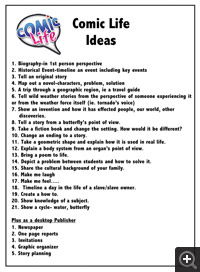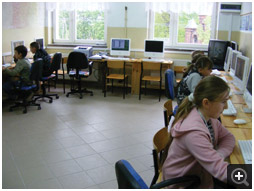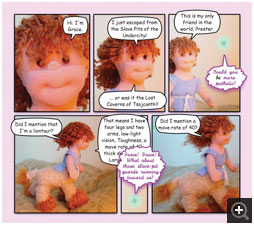The Benefits of Comic Life in Education
Making comics is fun for everyone, and Comic Life makes it easy. Teachers and students will find Comic Life a very useful software tool, and now it's available for both Mac and Windows platforms.
Technology not only changes how we write, but it also changes what writing is. Education will need to re-evaluate which writing skills teachers should pass to their students. Digital graphic writing is one genre students need to be fluent. Comic Life is the "word processor" of digital graphic writing.
Easy to Learn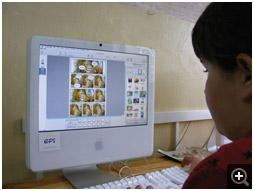
Students and teachers need only a short time to learn the basics of Comic Life. It's easy to add images from digital cameras, computer web-cameras, clip art from CD's and the web, stills from QuickTime movies, scanned photos and drawings – just about any on-screen image can be used in Comic Life. Adding captions and word balloons is as easy as drag and drop.
Inexpensive
Schools often don't have money to buy expensive software. At $19.95 for a single license, however, any teacher will find Comic Life a bargain, and administrators will find the cost of licensing Comic Life for labs affordable.
Inspires Creativity
Teachers are often asked to identify talented and gifted students by their ability to make "unusual connections." Talented and gifted students offer creative explanations for their answers which seem to come out of nowhere. Comic Life is the perfect software tool for all students to be creative. Comic Life will inspire everyone — teachers and students — to approach learning in new ways.
The Benefits of Comics in Education
Comics are beneficial to learning in the classroom and not just a fun art-enrichment activity.
Reading
Comics provide narrative experiences for students just beginning to read and for students acquiring a new language. Students follow story beginnings and endings, plot, characters, time and setting, sequencing without needing sophisticated word decoding skills. Images support the text and give students significant contextual clues to word meaning. Comics act as a scaffold to student understanding.
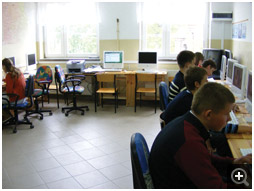 As Stephen Cary, a second language learner specialist and author of Going Graphic: Comics at Work in the Multilingual Classroom, says: "Comics provide authentic language learning opportunities for all students.... The dramatically reduced text of many comics make them manageable and language profitable for even beginning level readers."
As Stephen Cary, a second language learner specialist and author of Going Graphic: Comics at Work in the Multilingual Classroom, says: "Comics provide authentic language learning opportunities for all students.... The dramatically reduced text of many comics make them manageable and language profitable for even beginning level readers."
Also according to Cary, comics motivate reluctant readers. They engage students in a literary format which is their own. Comics speak to students in a way they understand and identify with. Even after students learn to be strong readers comics give students the opportunity to read material which combines images with text to express satire, symbolism, point of view, drama, puns and humor in ways not possible with text alone.
Writing
Many students read fluently, but find it difficult to write. They complain that they don't know what to write. They have ideas, but they lack the written language skills to create a beginning, follow a sequence of ideas and then draw their writing to a logical conclusion.
Students frequently ask if they may draw a picture when they're writing. They are reaching for images to support their language ideas. Allowed to use words and images they will resolve problems of storytelling which they would not otherwise experience using words alone. Like reading, comics provide a scaffolding so that students experience success in their writing. Students transfer specific elements directly into text-only writing. For example, students learn that whatever text found in a word balloon is put inside quotes in their text-only writing.
Using Comic Life students have a new publishing medium. Comic Life documents can be printed, emailed to parents or posted as a website very easily.
Key benefits of using comics in education
- A great visual Representation of Knowledge
- Presents what is essential
- Easier to remember a visual graphic containing key information
- Engaging through thinking, creating and writing.
- Perfect avenue for writing dialogue
- Incites students with low interest in writing
- Helps organization through storytelling and storyboarding
- Using visual images convey meaning to a story or topic
- Develops creative and higher level thought processes
- Develops composition techniques through visual-verbal connections
- Enriches reading, writing, and thinking
- Serves as and assessment and evaluation tool
- Sequencing promotes understanding
The key benefits for students using Comics, summarised by Marilee Sarlitto (Technology Director, Kildeer School), found in "Creating Comics: Visual and Verbal Thinking in the Ultimate Show and Tell" by Janette Combs, College of William and Mary, July 17, 2003.
Looking for Single Licenses or Education Volume Licensing? Please visit our Edu Store.
About the Author

As a child Glen Bledsoe taught himself to read by reading comics, although he admits that his teachers might have helped a little. Glen's love of comics led him to earn a degree in Art and pursue a career in writing. As a fourth grade teacher Glen has written many articles on education and technology for such organizations as the National Education Association, the Oregon Education Association, the National Writing Project, the Computing Teacher and many others. Glen uses Comic Life to produce a weekly comic strip for Salem-News.com called "Reverend Benny & Mister Sid's At Your Service". He and his wife are co-authors of over seventeen books for the school-library market. Watch for Glen's first novel The Charity of Ebenezer Scrooge.
What Teachers Say...

You're helping us get to the cutting edge of higher education in which students don't just read the experts and listen to lectures of professors. Our students will do all that, but they will also make their stories come to life--thanks to you.
Dr Kevin Williams, Shepherd University, West Virginia.

Comic format is ideal for youth and any forum where you want to seed the conversation with specific topics but allow the audience to participate by filling the blanks with their own experience/opinion/solutions.
Jim Reid, Bidwell Training Center
It has been awhile since I have been so excited about bringing a new piece of software into the elementary school environment. Comic Life is a perfect application for multiple grade levels and multiple subject areas. To keep projects short and simple, I use Comic Life with images found on the internet. It is a simple drag and drop process.
Marilee Sarlitto, Technology Director, Kildeer School
Comic Life Goes To School!
Comics are really a way of framing events, putting them in a sequence and choosing what the characters say. And this is really what media is all about, and what a good deal of art is about as well. It's a way of either telling your story that no-one would hear otherwise, or re-telling an event from your own perspective.
Comic Life makes it easy to sandbox this process, to let kids play and learn with these concepts; most other art forms and media manipulations are too slow to try iterations of ideas to learn from them.Kids these days are exposed to huge amounts of media, TV, computer games, movies, internet etc.
Comic Life makes an excellent tool to help them better understand the power (positive and negative) of the artform of media. example:
Comics as a way to understand the power of framing/perspective
-
Framing techniques, which are the same in movies, TV shows, computer games, photographs in newspapers etc. Comics let you re-frame the exact same information in different ways to get different effect; for example
- You can frame an image to make a person look dubious, or small, or powerful, or noble. This applies nicely to an understanding of how media frames certain issues and people
- How can different framing techniques effect how a person looks? A face shot is more personal, a full body shot less so
- If you zoom in, you can often lose the context of an image
- If you zoom out, you often lose the emotion on a face, or a particularly important focal point
- If a character is facing out of the frame, and the majority of 'space' in the frame is behind them, then the feeling will be ominous
- The organization and shape of frames can be used to make a scene look calm, or chaotic, or mechanical, exciting etc. How do advertisers do this?
- Artistically, the same photo can be used across multiple frames to imply motion of the character, or motion of the camera
- How can page layout, and story unfolding generate tension/release? "Will he make it?? Turn the page to find out...". Television series for example, use this same narrative techniques
- How can you change the meaning of the exact same comic with different text balloons? How about using the same text balloons and different images?
- How does context (the story before the story) affect the current story?
As an idea, perhaps you could give the exact same images to different students, and only using different panels and framing, let them make a simple comic. Their aim would be to give the 'consumer' an impression which you secretly hand to them on a piece of paper. For example, did the puppy steal the sandwich or not? Then have the class vote to see if they did sway the class' opinions.
Comics as a narrative device
- Pixar makes excellent use of storyboarding; all movies are meticulously story-boarded before work is started on a computer. Some of their DVDs contain excellent mini-documentaries on the process of storyboarding. Let the kids storyboard a movie, then make it themselves using iMovie/Windows Movie Maker software. How closely does the finished movie match the storyboard?
- Act out historical stories in comics, "to do is to know"
- Game comics - computer games are an important part of kids life and games like The Sims are often used to tell stories, utilising screenshots in comics. Red VS Blue is another popular use of game engines to tell a story.
- Stylistic changes from the 50's to comics. How are they different socially? What are some reversals of the stereotypes that kids could act out? Women saving a helpless man, Super-villains and Heroes negotiating to come to better understanding to avoid violence etc.
- What are some cultural differences between manga and western comic books - manga have a lot of close-up shots, and read back-to-front! Manga is very hip in the US currently
- Plasticine models/toys, and a movable iSight camera make for fast and flexible storytelling - the kids can adjust the characters and tell the story on the go, which is more about improvisation, another valid form of expression
-
Relationships between people. What are some different ways the same story could end. If there is a 'conflict' in the story, is there a way to resolve it/come to better understanding? Hollywood loves to blow stuff up to resolve issues, but there are other options
Tips to remember when using Comic Life
- Keep captions aligned within panels
- Adjust/tweak speech balloons so there is even space between the words and the edge
- Touch up dark/low contrast images by selecting the image and changing the sliders in its Details tab (required 10.4 on Mac)
- Make sure balloon tails come out of mouths, but not covering.
- Thought balloons originate from the temples, not the mouth
- Trial different panel and caption styles
Resources
Looking for Single Licenses or Education Volume Licensing? Please visit our Edu Store.
About the Author

As a child Glen Bledsoe taught himself to read by reading comics, although he admits that his teachers might have helped a little. Glen's love of comics led him to earn a degree in Art and pursue a career in writing. As a fourth grade teacher Glen has written many articles on education and technology for such organizations as the National Education Association, the Oregon Education Association, the National Writing Project, the Computing Teacher and many others. Glen uses Comic Life to produce a weekly comic strip for Salem-News.com called "Reverend Benny & Mister Sid's At Your Service". He and his wife are co-authors of over seventeen books for the school-library market. Watch for Glen's first novel The Charity of Ebenezer Scrooge.
What Teachers Say...

Comics have been used as a didactic aid for all type of subjects as a way to offer more friendly material to students. Taking advantage of this idea, we can propose comics as a format for scholastic works in different knowledge areas. With this strategy we can not only avoid the usual "copy and paste" from the students, but instead we force them to deepen their knowledge in the content which they must "expose" by translating their knowledge into "comic grammar".
Fran Iglesias, Proyecto Grimm, Technology and Education

The finished comic can be printed if you are lucky enough to have access to color ink, or saved as a webpage for students to share using a projection device. The webpage version doesn’t require you to be online to view it. If you plan to post the comics on a webpage, make sure that all images are copyright free.
Marilee Sarlitto, Technology Director, Kildeer School

A consideration for students/teachers is to escape the limits of presentation (Powerpoint) software. "Death by Powerpoint" is easily avoided through exploration of alternative graphic, video and paper-based (old-skool) presentation medium. Comic Life is a subtle and refined tool easily added to a presenter's kit...
Jim Reid, Bidwell Training Center



